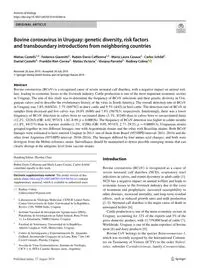
2019 Bovine coronavirus in Uruguay_ genetic diversity, risk factors and transboundary introductions from neighboring cou PDF
Preview 2019 Bovine coronavirus in Uruguay_ genetic diversity, risk factors and transboundary introductions from neighboring cou
Vol.:(0123456789) 1 3 Archives of Virology https://doi.org/10.1007/s00705-019-04384-w ORIGINAL ARTICLE Bovine coronavirus in Uruguay: genetic diversity, risk factors and transboundary introductions from neighboring countries Matías Castells1,2 · Federico Giannitti2 · Rubén Darío Caffarena2,3 · María Laura Casaux2 · Carlos Schild2 · Daniel Castells4 · Franklin Riet‑Correa2 · Matías Victoria1 · Viviana Parreño5 · Rodney Colina1 Received: 26 June 2019 / Accepted: 30 July 2019 © Springer-Verlag GmbH Austria, part of Springer Nature 2019 Abstract Bovine coronavirus (BCoV) is a recognized cause of severe neonatal calf diarrhea, with a negative impact on animal wel- fare, leading to economic losses to the livestock industry. Cattle production is one of the most important economic sectors in Uruguay. The aim of this study was to determine the frequency of BCoV infections and their genetic diversity in Uru- guayan calves and to describe the evolutionary history of the virus in South America. The overall detection rate of BCoV in Uruguay was 7.8% (64/824): 7.7% (60/782) in dairy cattle and 9.5% (4/42) in beef cattle. The detection rate of BCoV in samples from deceased and live calves was 10.0% (6/60) and 7.6% (58/763), respectively. Interestingly, there was a lower frequency of BCoV detection in calves born to vaccinated dams (3.3%, 8/240) than in calves born to unvaccinated dams (12.2%, 32/263) (OR: 4.02, 95%CI: 1.81–8.90; p = 0.00026). The frequency of BCoV detection was higher in colder months (11.8%, 44/373) than in warmer months (1.5%, 3/206) (OR: 9.05, 95%CI: 2.77–29.53, p = 0.000013). Uruguayan strains grouped together in two different lineages: one with Argentinean strains and the other with Brazilian strains. Both BCoV lineages were estimated to have entered Uruguay in 2013: one of them from Brazil (95%HPD interval: 2011–2014) and the other from Argentina (95%HPD interval: 2010–2014). The lineages differed by four amino acid changes, and both were divergent from the Mebus reference strain. Surveillance should be maintained to detect possible emerging strains that can clearly diverge at the antigenic level from vaccine strains. Introduction Bovine coronavirus (BCoV) is recognized as a cause of severe neonatal calf diarrhea (NCD), respiratory tract infections in calves, and winter dysentery in adult cattle [1]. NCD has a negative impact on animal welfare and leads to economic losses to the livestock industry due to the costs of treatment and prophylaxis, increased susceptibility to other diseases, increased mortality, and long-term residual effects, such as reduced growth rates and milk production [2–5]. Neonatal calf diarrhea is the major cause of death in unweaned heifers [6]. Cattle production is one of the main economic sectors in Uruguay, accounting for 33% of the exports and 5% of the gross domestic product, with 11,739,000 head of cattle [7]. Worldwide, Uruguay is one of the main exporters of bovine meat [8] and dairy products [9]. Bovine CoV belongs to the species Betacoronavirus 1, which was recently assigned by the International Commit- tee on Taxonomy of Viruses (ICTV) to the order Nidovi- rales, suborder Cornidovirineae, family Coronaviridae, Handling Editor: Zhenhai Chen. Rubén Darío Caffarena and María Laura Casaux, Carlos Schild contribute equally to this work. Electronic supplementary material The online version of this article (https ://doi.org/10.1007/s0070 5-019-04384 -w) contains supplementary material, which is available to authorized users. * Rodney Colina
